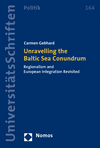Zusammenfassung
Seit 1989 ist es im Ostseeraum zu einer explosionsartigen Entstehung einer Vielzahl von regionalen Initiativen und Zusammenschlüssen gekommen. Der Ostseeraum weist bis heute eine europaweit einzigartig hohe Konzentration an kooperativen regionalen Strukturen auf. Diese bilden gemeinsam ein enges Netzwerk von Vereinigungen, die unter dem Überbegriff der "Ostseezusammenarbeit’ interagieren.
Diese Studie analysiert die Hintergründe dieses regionalen Phänomens oder so genannten „Ostsee-Rätsels“ auf Basis eines Vergleichs zwischen den Regionalpolitiken zweier staatlicher Schlüsselakteure, Schweden und Finnland, wobei der europäische Integrationsprozess als übergeordneter Bezugsrahmen für die Untersuchung dient.
Abstract
Seit 1989 ist es im Ostseeraum zu einer explosionsartigen Entstehung einer Vielzahl von regionalen Initiativen und Zusammenschlüssen gekommen. Der Ostseeraum weist bis heute eine europaweit einzigartig hohe Konzentration an kooperativen regionalen Strukturen auf. Diese bilden gemeinsam ein enges Netzwerk von Vereinigungen, die unter dem Überbegriff der "Ostseezusammenarbeit’ interagieren.
Diese Studie analysiert die Hintergründe dieses regionalen Phänomens oder so genannten „Ostsee-Rätsels“ auf Basis eines Vergleichs zwischen den Regionalpolitiken zweier staatlicher Schlüsselakteure, Schweden und Finnland, wobei der europäische Integrationsprozess als übergeordneter Bezugsrahmen für die Untersuchung dient.
- 13–14 Introduction 13–14
- 41–48 IV. Typologies 41–48
- 104–108 I. Policy Outline 104–108
- 228–230 Epilogue 228–230
- 261–279 Bibliography 261–279

